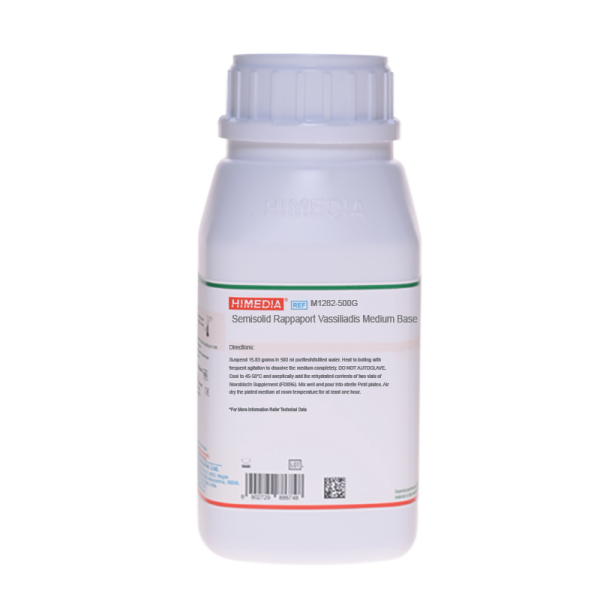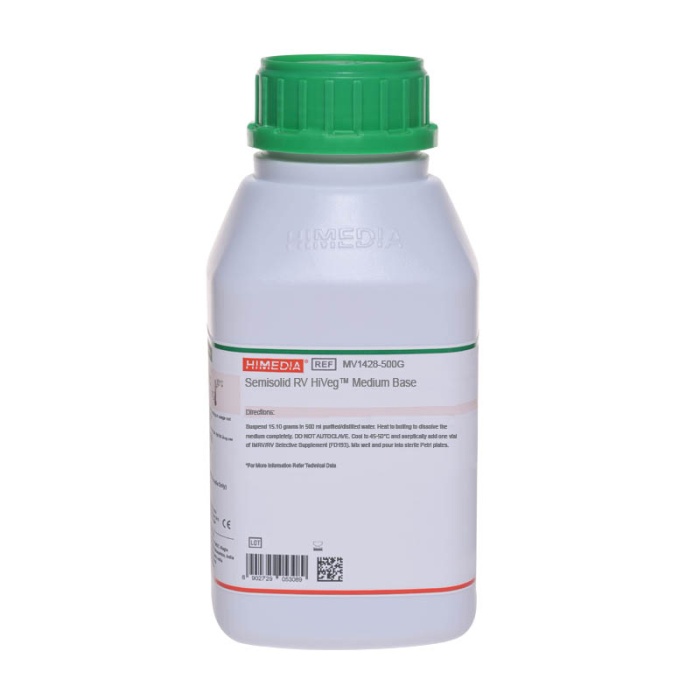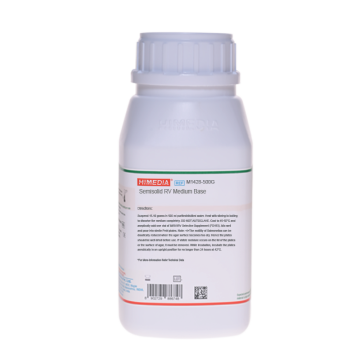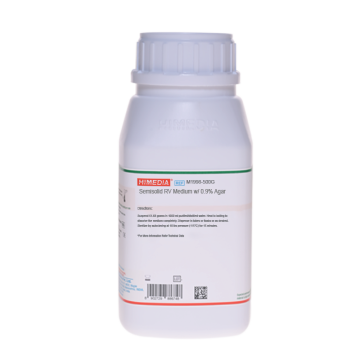 Your enquiry has been submitted
Your enquiry has been submitted
Semisolid Rappaport Vassiliadis Medium Base, Modified
Salmonella species#CC293D
Intended Use
Used for the detection of motile Salmonella species from food, faeces and environmental specimens.
Composition**
| Ingredients | g/L |
|---|---|
| Tryptose | 4.590 |
| Tryptone | 4.590 |
| Sodium chloride | 7.340 |
| Potassium dihydrogen phosphate | 1.470 |
| Magnesium chloride, anhydrous | 10.930 |
| Malachite green oxalate | 0.037 |
| Agar | 2.700 |
Final pH (at 25°C) 5.2±0.2
**Formula adjusted, standardized to suit performance parameters
Directions
Suspend 31.66 grams in 1000 ml distilled water. Heat to boiling with frequent agitation to dissolve the medium completely. DO NOT AUTOCLAVE. Cool to 45-50°C and aseptically add the rehydrated contents of 1 vial of NO 20 Selective Supplement (FD290) or 4 vials of NO 5 Selective Supplement (FD096). Mix well and pour into sterile Petri plates. Air dry the plated medium at room temperature for at least one hour.
Principle And Interpretation
Semisolid Rappaport Vassiliadis Medium, Modified is prepared as per the formulation described by DeSmedt et al (1), for the detection of motile Salmonella species from food and environmental specimens. This medium detects more Salmonella positive samples than the routinely used enrichment procedures (2,3,4).
Tryptose, tryptone provide the nitrogenous and carbonaceous substances and other essential growth nutrients. Phosphate gives good buffering capacity to the medium. Malachite green oxalate and Novobiocin inhibits many gram positive bacteria. The working of medium is based on the ability of Salmonella species to migrate in the selective medium by competing with the other motile organisms, thus producing opaque halos of growth. This medium can be used in combination with direct culture and Selenite F Broth (M052A) enrichment for isolation of Salmonella species from faeces and subculturing on XLD Agar (M031) or Mannitol Lysine Agar (M1071) results in higher recovery rates (5). This medium is not suitable for the detection of non-motile strains of Salmonella (6). Inoculate 3 drops (0.1 ml) of pre- enrichment culture (16-20 hours old) in separate spots on the air-dried medium surface. Incubate the plates in an upright position at 42°C for upto 24 hours. The motile bacteria will show a halo or zone of growth originating from inoculation spot. Salmonella species show straw coloured colonies. Sub-cultures can be carried out from the outside edge of the halo to confirm purity and for further biochemical and serological tests.
Type of specimen
Clinical samples - Faeces, Food samples: meat and meat products
Specimen Collection and Handling:
For clinical samples follow appropriate techniques for handling specimens as per established guidelines (7,8).
For food samples, follow appropriate techniques for sample collection and processing as per guidelines (9).
After use, contaminated materials must be sterilized by autoclaving before discarding.
Warning and Precautions
In Vitro diagnostic Use. For professional use only. Read the label before opening the container. Wear protective gloves/ protective clothing/eye protection/ face protection. Follow good microbiological lab practices while handling specimens and culture. Standard precautions as per established guidelines should be followed while handling clinical specimens. Safety guidelines may be referred in individual safety data sheets.
Limitations :
- Due to variable nutritional requirements, some strains show poor growth on this medium.
- The plates should be incubated in upright and steady position as medium contains less agar.
- Air dried plate should be used, or it may give erroneous results.
Performance and Evaluation
Performance of the medium is expected when used as per the direction on the label within the expiry period when stored at recommended temperature.
Quality Control
Appearance Light yellow to light blue homogeneous free flowing powder
Gelling Semisolid, comparable with 0.27% Agar gel.
Colour and Clarity of prepared medium Greenish blue coloured clear to slightly opalescent semisolid gel forms in Petri plates which may have a slight precipiate.
Reaction Reaction of 3.16% w/v aqueous solution at 25°C. pH : 5.2±0.2
pH 5.00-5.40
Cultural Response
Cultural characteristics observed after an incubation at 42-43°C for 18-24 hours with added NO 20 Selective Supplement (FD290) or NO 5 Selective Supplement (FD096).
| Organism | Inoculum (CFU) | Growth at 42±1°C | Motility |
|---|---|---|---|
| Citrobacter freundii ATCC 8090 (00006*) | 50-100 | none-poor | negative reaction, no colour change |
| Escherichia coli ATCC 25922 (00013)* | 50-100 | none-poor | negative reaction, no colour change |
| Salmonella Typhi ATCC 6539 | 50-100 | good-luxuriant | positive reaction, colourless to light pink zone |
| Salmonella Typhimurium ATCC 14028 (00031*) | 50-100 | good-luxuriant | positive reaction, colourless to light pink zone |
| Salmonella Enteritidis ATCC 13076 (00030*) | 50-100 | good-luxuriant | positive reaction, colourless to light pink zone |
Key: *Corresponding WDCM numbers.
Storage and Shelf Life
Store between 10-30°C in a tightly closed container and the prepared medium at 2-8°C. Use before expiry date on the label.
On opening, product should be properly stored dry, after tightly capping the bottle in-order to prevent lump formation due to the hygroscopic nature of the product. Improper storage of the product may lead to lump formation. Store in dry ventilated area protected from extremes of temperature and sources of ignition Seal the container tightly after use. Product performance is best if used within stated expiry period.
Disposal
User must ensure safe disposal by autoclaving and/or incineration of used or unusable preparations of this product. Follow established laboratory procedures in disposing of infectious materials and material that comes into contact with clinical sample must be decontaminated and disposed of in accordance with current laboratory techniques (7,8).
Reference
- De Smedt J.M., Balderdijk R., Rappold H. and Lautenschlaeger D., 1986, J. Food Prot., 49:510.
- De Smedt J.M., Balderdijk R., 1987, J. Food Prof., 50:658.
- De Zutter L. et al, 1991, Int. J. Food Microbiol., 13:11.
- De Smedt J.M. et al, 1991, Int. J. Food Microbiol., 13:301.
- Holbrook R. et al, 1989, Lett. Appl. Microbiol., 8:139.
- Aspinall S.T., Hindle M.A. and Hutchinson D.N., 1992, Europ. J. Clin. Microbiol. Inf. Dis., 11:936.
- Isenberg, H.D. Clinical Microbiology Procedures Handbook. 2nd Edition.
- Jorgensen, J.H., Pfaller, M.A., Carroll, K.C., Funke, G., Landry, M.L., Richter, S.S and Warnock., D.W. (2015) Manual of Clinical Microbiology, 11th Edition. Vol. 1.
- Salfinger Y., and Tortorello M.L., 2015, Compendium of Methods for the Microbiological Examination of Foods, 5th Ed., American Public Health Association, Washington, D.C.
| Product Name | Semisolid Rappaport Vassiliadis Medium Base, Modified |
|---|---|
| SKU | M1282 |
| Product Type | Regular |
| Physical Form | Powder |
| Origin | Animal |
| Packaging type | HDPE |
| References | 1. De Smedt J.M., Balderdijk R., Rappold H. and Lautenschlaeger D., 1986, J. Food Prot., 49:510. |
| Customized Product Available | No |











